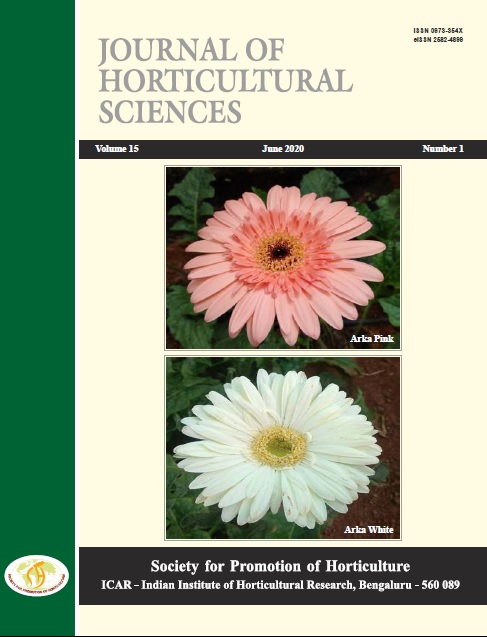Breeding for Improvement of High Temperature Tolerance in Garden Pea (Pisum sativum L.) for off Season Cultivation
DOI:
https://doi.org/10.24154/jhs.v15i1.784Keywords:
Breeding, Early summer, Garden pea, High temperature, Stress toleranceAbstract
The present investigation is aimed towards breeding varieties of garden pea for early summer cultivation (March-May) that can tolerate temperatures up to 35 0C. High temperature tolerant accessions KTP-4, Arka Sampoorna, Oregon Sugar, Magadi local were crossed with Arka Ajit, Arka Pramodh, Arka Priya having superior pod quality, yield and followed by pedigree method of breeding, superior transgressive segregants from these crosses were advanced up to F 7 generation. In F 7, six selected advanced breeding lines were assessed for their performance in the field with checks during early summer for four years in succession. Results revealed significant differences between selected lines and checks wherein all the lines surpassed checks with yield ranging from 5.9-7.6 t/ ha and in checks it was only 2.6-3.1 t/ha. Among these six breeding lines, three lines were selected based on high yield (6.7-7.6 t/ha), pod quality characters and identified to be highly suitable for early summer cultivation.
Downloads
References
Bita, C.E. and Gerats, T. 2013. Plant tolerance to high temperature in a changing environment: scientific fundamentals and production of heat tolerance crops. Front. Plant Sci.,4: 273. https://doi.org/10.3389/fpls.2013.00273 DOI: https://doi.org/10.3389/fpls.2013.00273
Bueckert, R. A., Wagenhoffer,S., Hnatowich, G. and Warkentin, T.D. 2015. Effect of heat and precipitation on pea yield and reproductive performance in the field. Can. J. Plant Sci., 95: 629-639. https://doi.org/10.4141/cjps-2014-342 DOI: https://doi.org/10.4141/cjps-2014-342
Dahl, W.J., Foster, L.M. and Tyler, R.T. 2012. Review of the health benefits of peas (Pisum sativum L.). Br. J. Nutr.,108: S3-S10.https://doi.org/10.1017/S0007114512000852 DOI: https://doi.org/10.1017/S0007114512000852
Guilioni, L., Wery, J. and Lecoeur, J. 2003. High temperature and water deficit may reduce seed number in field pea purely by decreasing plant growth rate. Funct. Plant Biol., 30: 1151-1164.DOI: 10.1071/FP03105. DOI: https://doi.org/10.1071/FP03105
Guilioni, L., Wery,J. and Tardieu,F. 1997. Heat stress- induced abortion of buds and flowers in pea, is sensitivity linked to organ age or to relations between reproductive organs? Ann. Bot.,80: 159-168. DOI: https://doi.org/10.1006/anbo.1997.0425
Jeuffroy, M.H., Duthion, C., Meynard, J.M. and Pigeaire, A. 1990. Effect of a short period of high day temperatures during flowering on the seed number per pod of pea (Pisum sativumL) Agronomie, 2: 139-145. DOI: https://doi.org/10.1051/agro:19900207
Lambert, R.G. and Linck, A. 1958. Effects of high temperature on yield of peas. Plant Physiol.,33: 347-350. DOI: https://doi.org/10.1104/pp.33.5.347
Mohan, N., Aghora, T.S., Wani, M.A. and Divya, B. 2013. Garden pea improvement in India. J. Hortl. Sci., 8:125-164. DOI: https://doi.org/10.24154/jhs.v8i2.236
NHB database, National Horticultural Board 2018-19, 1st advance estimates.
Petkova, V., Nikolova, V., Kalapchieva,S.H., Stoeva,V., Topalova, E. and Angelova, S. 2009. Physiological response and pollen viability of Pisum sativum genotypes under high temperature influence. Proceedings IV Balkan Symposium on
Vegetables and Potato, 830: 665-71. https://doi.org/10.17660/actahortic.2009.830.96 DOI: https://doi.org/10.17660/ActaHortic.2009.830.96
Poggio, S.L., Satore, E.H., Dethiou, S. and Gonzalo, G.M. 2005. Pod and seed numbers as a function of photothermal quotient during the seed set period of field pea (Pisum sativum) crops. Eur.J. Agron., 22: 55-69. DOI: https://doi.org/10.1016/j.eja.2003.12.003
Prasad, P.V.V., Boote, K.J., Allen, L.H. and Thomas, J.M.G. 2002. Effect of elevated temperature and carbon dioxide on seed-set and yield of kidney bean (Phaseolus vulgarisL.) Global Change in Biol., 8: 710-721. DOI: https://doi.org/10.1046/j.1365-2486.2002.00508.x
Suzuki, N., Rivero, R.M.,Shulaev, V.,Blumwald, E. and Mittler, R. 2014. Abiotic and biotic stress combinations.New Phytol., 203: 32-43. https://doi.org/10.1111/nph.12797 DOI: https://doi.org/10.1111/nph.12797
Todorova, D., Katerova,Z., Shopova,E., Jodinskiene,M., Jurkoniene, S. and Sergiev, I.2016. Responses of pea plants to heat stress and spermine treatment. Zemdirbyste-Agric., 103 : 99-106. DOI: 10.13080/z-a.2016.103.013 DOI: https://doi.org/10.13080/z-a.2016.103.013
Vijaylaxmi. 2013. Effect of high temperature on growth, biomass and yield of field pea. Leg. Res., 36: 250-254.
Downloads
Published
Issue
Section
License
Copyright (c) 2020 Susmita C, Aghora T S, Mohan N, Bhatt R M (Author)

This work is licensed under a Creative Commons Attribution-NonCommercial-ShareAlike 4.0 International License.
Authors retain copyright. Articles published are made available as open access articles, distributed under the terms of the Creative Commons Attribution-NonCommercial-ShareAlike 4.0 International License, which permits unrestricted non-commercial use, distribution, and reproduction in any medium, provided the original author and source are credited. 
This journal permits and encourages authors to share their submitted versions (preprints), accepted versions (postprints) and/or published versions (publisher versions) freely under the CC BY-NC-SA 4.0 license while providing bibliographic details that credit, if applicable.





 .
. 











